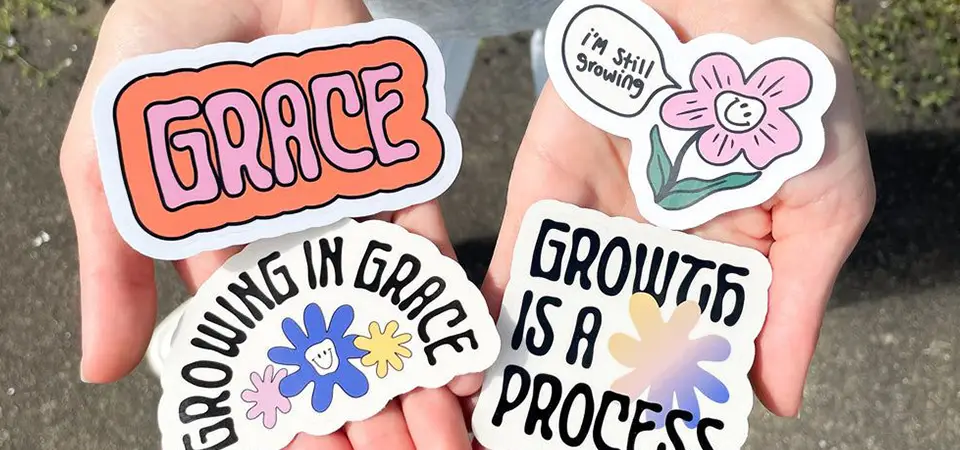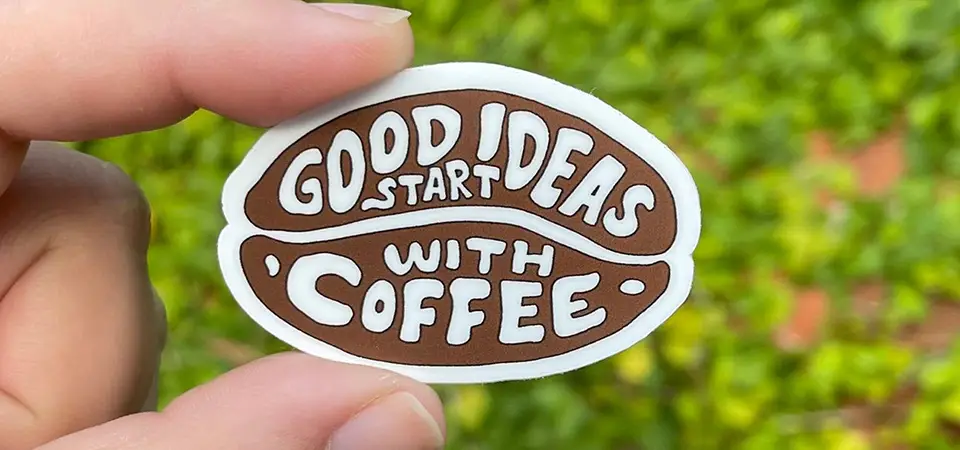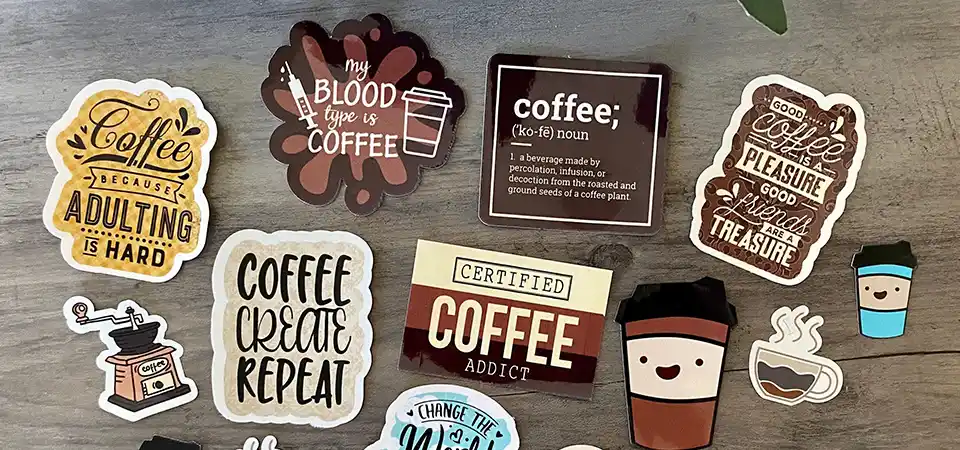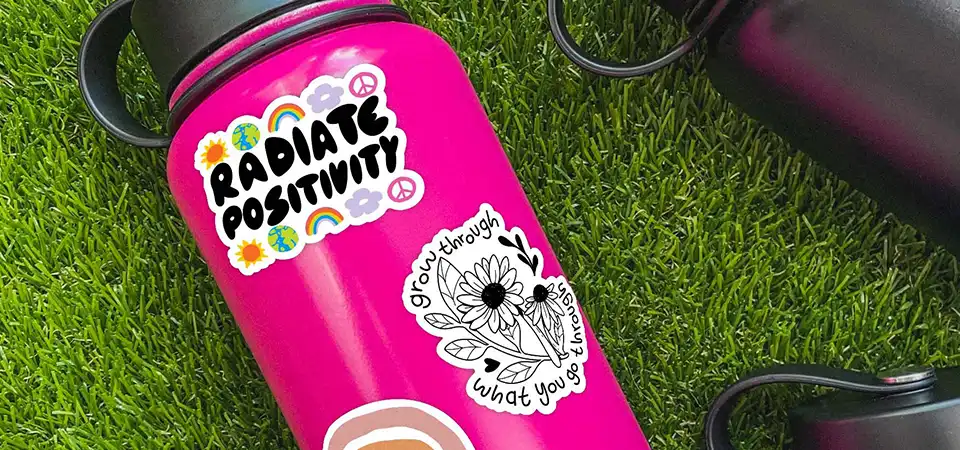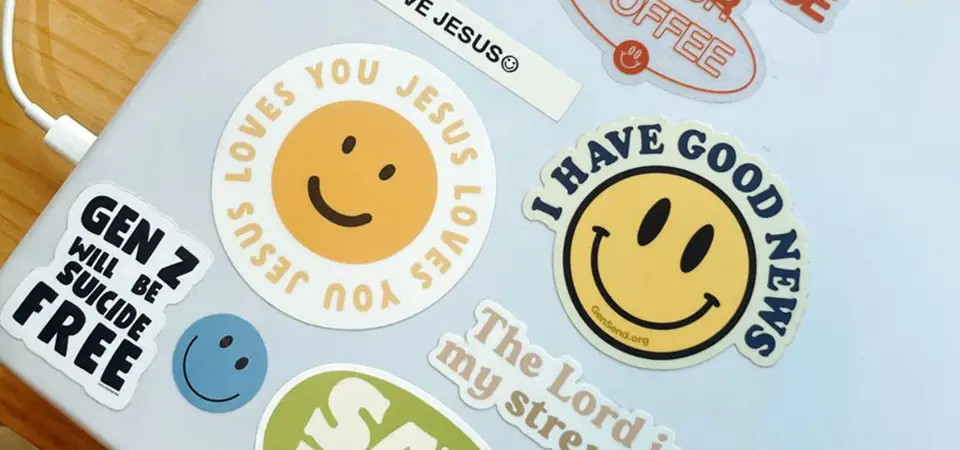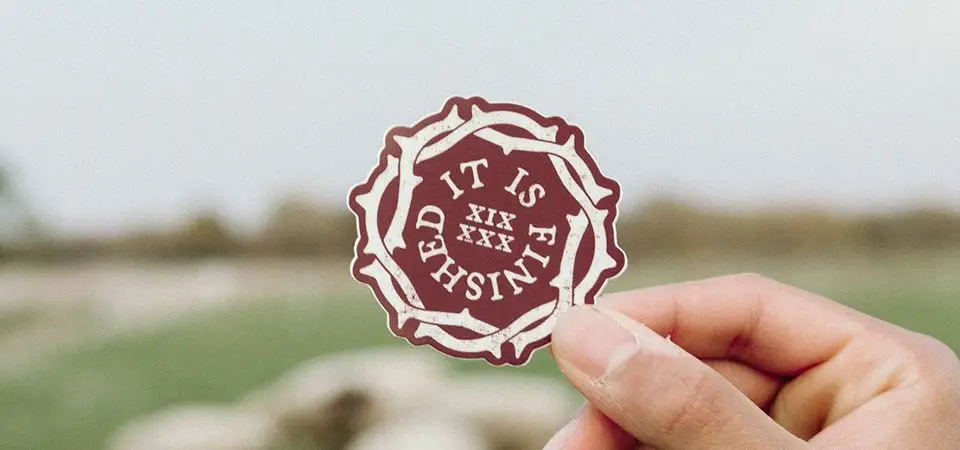Stickers are everywhere, but their history is hidden. You might think they're just fun decorations, but you're missing the story of their evolution into powerful marketing tools.
Stickers evolved from practical 1930s industrial labels into cultural phenomena. Each decade introduced new materials and uses—from 1960s political statements and 1980s collectibles to today's custom-cut stickers used for branding, art, and personal expression in a digital world.
As a sticker marketing expert, I find this evolution fascinating. It's a reflection of our changing society. The journey shows how a simple adhesive product became a voice for movements, a hobby for kids, and a vital tool for businesses like mine. It started with an inventor named R. Stanton Avery, who created the first self-adhesive label in 1935. But it took a few decades for his invention to go from a simple pricing tag to a cultural force. Let's peel back the layers on this amazing journey.
1960s: Was This the Birth of 'Stickermania'?
You see bumper stickers on cars all the time. But where did this trend start? This was a new, loud way for people to share their views publicly.
The 1960s transformed stickers into tools for expression. The invention of pressure-sensitive adhesive combined with social movements turned bumper stickers into a widespread phenomenon for political protest, advertising, and counter-culture identity, kicking off the first wave of "stickermania."
The 1960s was the perfect storm for the sticker to become a star. The technology was finally ready for the public, and the public was ready to make some noise. This decade turned the humble sticker into a vehicle for ideas.
The Technology Meets the Moment
While the self-adhesive label was invented in the 30s, it took time for the technology to become affordable and widespread. By the 1960s, printers could mass-produce these "pressure-sensitive" stickers easily. You no longer needed water or messy glue. You could just peel and stick. This simple innovation opened the door for a new form of communication. Forest Gill, a printer from Kansas City, is credited with combining this tech with fluorescent inks and day-glo papers to create what we know as the modern bumper sticker.
A Voice for the People
The 1960s was a decade of intense social and political change. People had strong opinions about the Vietnam War, civil rights, and politics, and they were looking for new ways to express them. The bumper sticker was the perfect medium. It was cheap, easy to distribute, and turned any car into a mobile billboard. It was a way for ordinary people to broadcast their beliefs to the world. In my business, we still see echoes of this. When a brand that stands for something uses stickers, they are tapping into the same powerful idea that started in the 60s.
1970s: Why Did Everyone Start Collecting Stickers?
Remember trading cards as a kid? In the 70s, it was all about sticker albums. Kids were obsessed, and brands took notice of this powerful new marketing trend.
The 1970s made stickers a collectible hobby, especially for kids. Companies like Panini created sticker albums for sports and pop culture. This turned stickers into a product themselves, driving sales through the desire to "collect them all" and trade with friends.
After the 60s established the sticker as a tool for expression, the 70s turned it into a commercial powerhouse. Brands realized that stickers were not just for advertising a message; the sticker itself could be the product. This decade was all about the thrill of the collection.
The Rise of the Sticker Album
The Italian company Panini was a genius at this. They released their first FIFA World Cup sticker album in 1970. The concept was simple but brilliant. You would buy an empty album and then purchase sealed, waxy packets of stickers, never knowing which players you would get inside. The goal was to fill the entire album by collecting and trading with friends. This created a massive market built on the thrill of the hunt. It was a craze that swept across the world, and I remember friends being obsessed with completing their collections.
Stickers as a Sensory Experience
The 70s also brought us one of the most memorable sticker innovations: scratch-and-sniff. These stickers, created by 3M using their microencapsulation technology, added another layer to the experience. Now, stickers could be seen, touched, and smelled. Iconic scents like pizza, grass, and chocolate became must-have items for any kid's collection. This collectible mindset is something we leverage in my business today. When we create a series of limited-edition stickers for a client, we're tapping into that same 70s desire to complete a set.
1980s: How Did Stickers Take Over Pop Culture?
The 80s were loud and bold. Your folders and Trapper Keepers were covered in stickers. They weren't just collectibles; they were a way to show off who you were.
The 1980s saw stickers explode as tools for personalization, fueled by vibrant pop culture. From scratch-and-sniff and puffy stickers to band logos and movie characters, stickers became essential for kids and teens to decorate their belongings and express their identity.
If the 70s were about collecting, the 80s were about personalizing. Stickers moved out of albums and onto every available surface. They became a fundamental part of youth identity and pop culture. I remember this time vividly; our school supplies were our personal canvases.
A Sticker for Every Style
The variety of stickers in the 80s was incredible. You had stickers that perfectly matched the bold, colorful aesthetic of the decade. This was the golden age of sticker companies that became brands in their own right.
| Sticker Type | Description | Popular Use |
|---|---|---|
| Puffy Stickers | Soft, 3D foam stickers | Decorating bedroom furniture, notebooks. |
| Lisa Frank | Neon and rainbow-colored animals | Covering Trapper Keepers and school folders. |
| Oilies/Prismatics | Shiny, holographic-like stickers | Trading and decorating anything and everything. |
| Band/Movie Stickers | Logos from bands, movies, and TV shows | Showcasing your favorite media on lunchboxes. |
The Badge of Fandom
In the 80s, a sticker was a badge that showed what you were into. A Ghostbusters sticker on your lunchbox or a Powell-Peralta skate sticker on your deck wasn't just decoration; it was a statement. It told the world what music you listened to, what movies you loved, and what groups you belonged to. This idea of using stickers to claim ownership and show what you love is the core reason why brand stickers are so effective today. When someone puts your brand's sticker on their laptop, they are making it part of their personal identity.
1990s: Was This the Peak of 'Stickermania'?
Think about the 90s. Stickers were absolutely everywhere. From skate culture to brand giveaways, they defined the decade's aesthetic, but was this the highest point of their popularity?
The 1990s arguably represented peak "stickermania," where stickers became deeply embedded in youth subcultures like skateboarding and alternative music. They were less about collecting and more about authentic brand affiliation and guerilla marketing, slapped on everything from lampposts to laptops.
The 90s took the personalization of the 80s and gave it a gritty, authentic edge. Stickers became less about cute characters and more about attitude. This was the decade where stickers became a core part of street culture and alternative movements.
From the Bedroom to the Streets
While 80s stickers were often neatly placed on personal items, 90s stickers were slapped everywhere. Skate culture led the way. Skaters would cover their decks with stickers from their favorite brands like World Industries or Alien Workshop. This "sticker bomb" aesthetic quickly spread. Lampposts, street signs, and club bathrooms became public galleries for stickers from bands, record labels, and skate shops. A sticker wasn't just something you owned; it was something you put out into the world. It was a form of low-key graffiti that marked your presence.
The Sticker as Proof
In the 90s, the right sticker was a sign that you were "in the know." Having a sticker from an underground punk band or an indie record label like Sub Pop showed you were part of a scene. These weren't stickers you could buy at any big store. You got them at shows, in record sleeves, or from a skate shop. This exclusivity gave them immense cultural value. This is where the idea of a sticker as a badge of honor really took hold. When a coffee shop client gives out a cool vinyl sticker today, they're hoping for this 90s effect—for their brand to become part of someone's identity.
2000s: How Did Digital Technology Change Stickers?
The internet changed everything, even stickers. Suddenly, anyone could design and order their own custom stickers online. This created a huge shift away from mass-produced designs.
In the 2000s, the rise of the internet and digital printing revolutionized stickers. Online printing services made it easy and affordable for small businesses, bands, and individuals to create their own high-quality, custom die-cut stickers, democratizing sticker production.
This is the decade my industry was born. The 2000s broke down the barriers to sticker production. You no longer had to be a huge company to make professional-looking stickers. The power to create was now in everyone's hands.
The Digital Printing Revolution
Two key technologies came together: the internet and digital printing. The internet created a global marketplace where anyone could upload a design. Digital printing presses and cutting plotters made it possible to produce small batches of stickers affordably. Before this, you had to order thousands of stickers at a time, which was too expensive for a small band, an independent artist, or a local coffee shop. Suddenly, the minimum order quantity (MOQ) dropped from thousands to just 50 or 100. This was a game-changer.
The Rise of the Creator
This technological shift fueled the "indie" movement. Artists on sites like DeviantArt could turn their digital art into physical products. Bands could sell their own stickers at their merch tables. Small businesses could create professional branding materials that competed with the big guys. I saw how digital printing allowed a local bakery to have stickers that were just as cool as a global brand like Coca-Cola. That's exactly why I started my company, Sticker Printing China—to give that power and quality to every single business, no matter their size.
2010s-2020s: How Are Stickers Used in the Social Media Age?
Your phone is full of them. Digital stickers dominate our chats. But physical stickers are more popular than ever. How can both be true at the same time?
In the social media era, stickers thrive both digitally and physically. Digital stickers dominate online communication, while high-quality vinyl stickers have become essential marketing tools for e-commerce brands, often included in unboxing experiences.
We now live in a dual world where stickers are both pixels on a screen and durable vinyl on a water bottle. Instead of competing, these two forms of stickers actually work together, creating a perfect loop of branding and expression.
The Digital and the Physical
Digitally, stickers have become a language. We use them on Instagram, WhatsApp, and iMessage to add emotion and humor to our conversations. They are a fast and visual way to communicate. At the same time, the physical sticker has become a premium item. People carefully curate the stickers on their laptops and Hydro Flasks. Each sticker is chosen to represent a brand they love, a place they've been, or an idea they support. It's a physical representation of their personal online profile.
The Unboxing Experience
A huge part of my business now serves e-commerce brands, and they understand this new reality. They know that including a free, high-quality die-cut sticker in a package is one of the most effective marketing moves they can make. When a customer opens a box and finds a cool sticker, they feel rewarded. They often take a picture of it and share it on social media. The physical sticker directly fuels digital sharing and brand awareness. It’s a small investment that creates a powerful and authentic connection with a customer.
What Is the Future of Stickers?
We've seen stickers evolve from paper labels to digital icons. What could possibly be next? The future is smarter and more interactive than you might think.
The future of stickers lies in technology and sustainability. We can expect to see more interactive stickers with embedded NFC chips or AR triggers, as well as a greater demand for eco-friendly, compostable materials that reduce environmental impact.
As a business owner in this space, I am always looking at what's next. The sticker is not done evolving. The next wave will blend the physical sticker with the digital world in new and exciting ways, and it will be done more responsibly.
Smart and Sustainable Stickers
The next big leap is technology. Imagine a sticker with an NFC (Near Field Communication) chip inside. You could tap your phone on a sticker on a movie poster to instantly watch the trailer. Or tap a sticker on a coffee cup to join the loyalty program. Augmented Reality (AR) stickers could bring a brand's logo to life with a 3D animation when you view it through your phone.
At the same time, there is a huge push for sustainability. Customers want to know that the products they use are not harming the environment. As a printer, I'm already seeing a huge increase in requests for eco-friendly materials like compostable paper, PVC-free vinyl, and non-toxic inks. Offering sustainable options is no longer a bonus; it's becoming a necessity. The future is about creating stickers that are not only smarter but also kinder to our planet.
Conclusion
From simple labels to interactive marketing tools, stickers constantly evolve. They reflect our culture and technology, and their journey of connection and expression continues to unfold.


